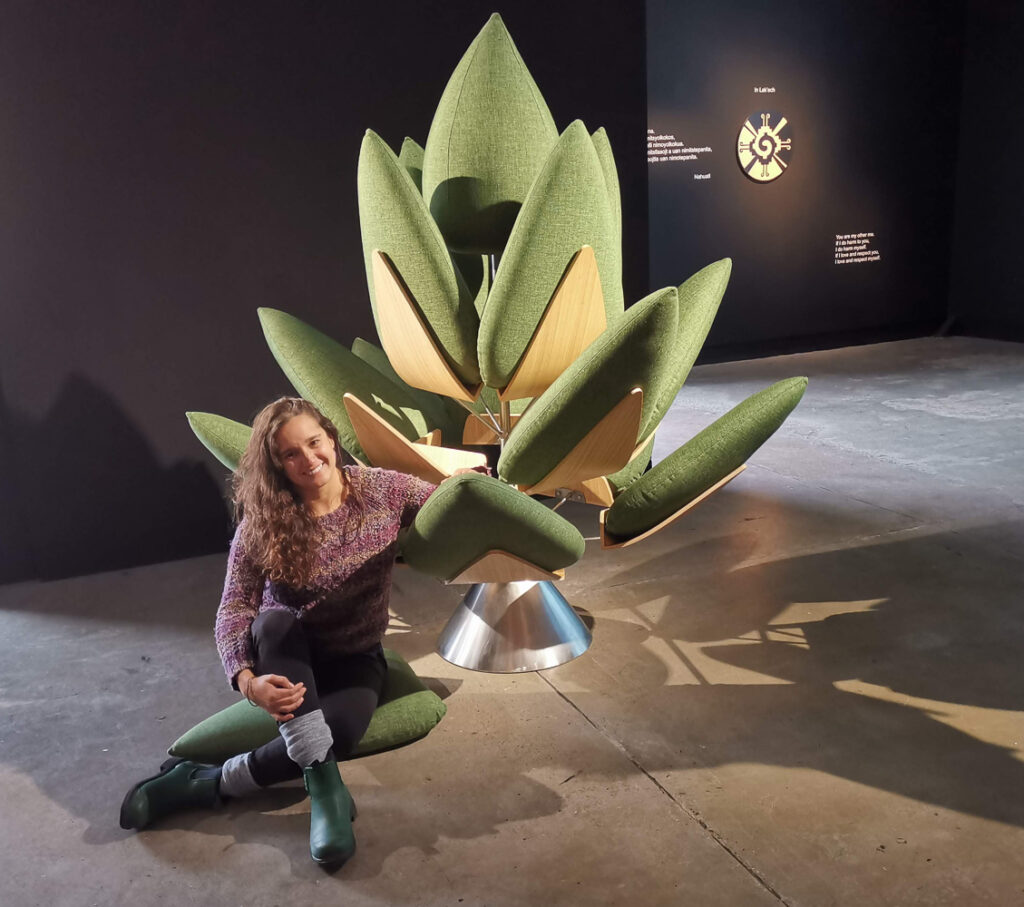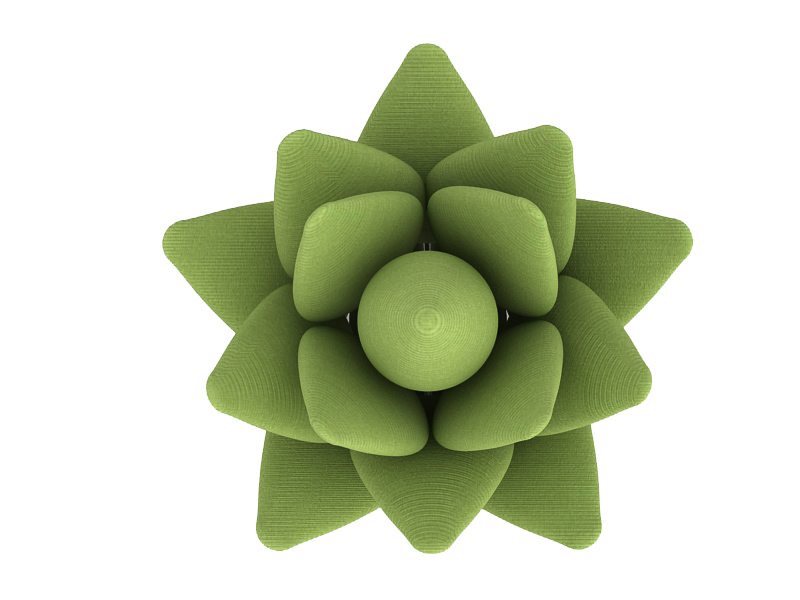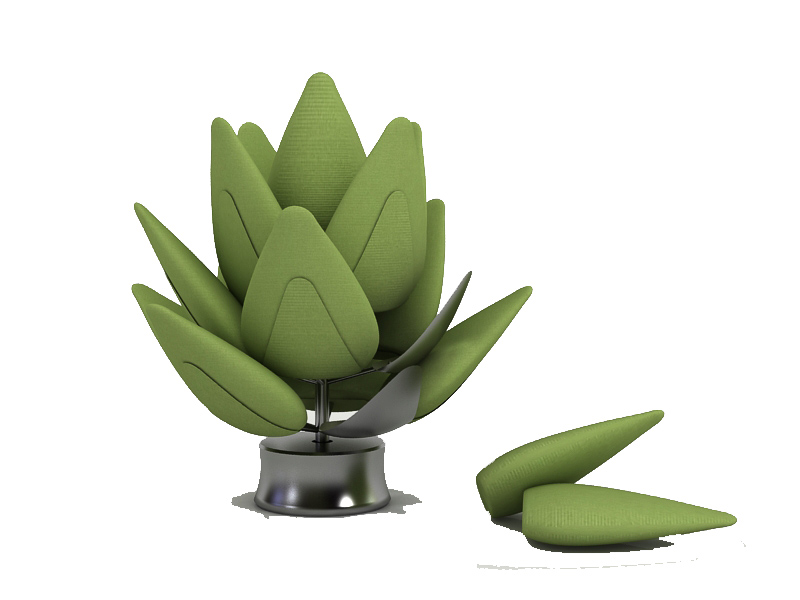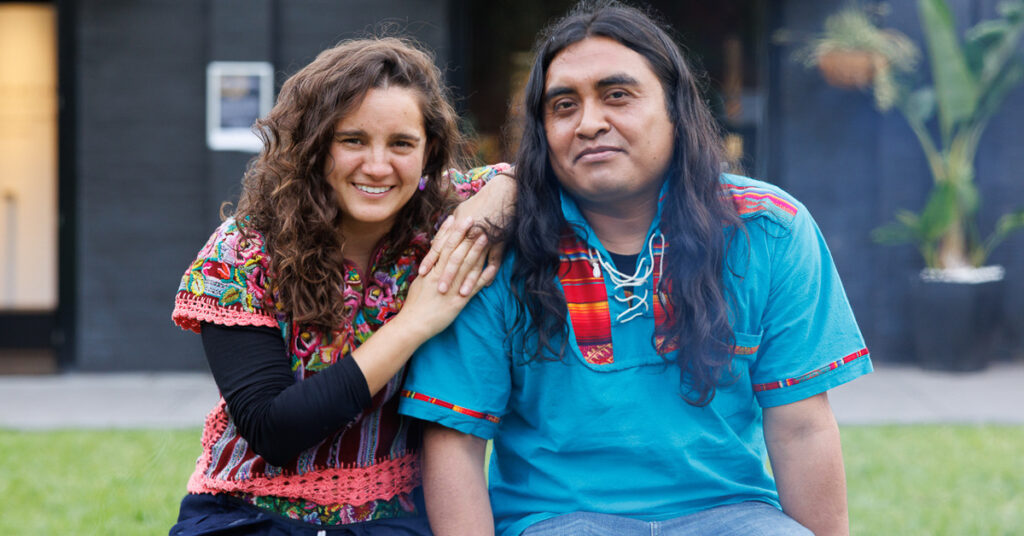
Desiree Ibinarriaga, Agave, Furniture-sculpture Materials: Fabric, timber, stainless steel and sand. 1.52 m
Desiree Ibinarriaga and David Marcelino Cayetano bring people together through their Nahuatl culture.
(A message to the reader.)
For us, Indigenous peoples, we belong to the land, the land does not belong to us. We live in oneness with our Mother Earth, she is our everything, with her everything, without her nothing. She nurtures us, she is wise, and teaches us to read and understand her. Such as life, she can be gentle, caring, loving but if we do not understand her or we do not take care of her she can give us tough love. She is alive and she feels, she feels us, she feels other Entities.
Indigenous cosmology is multidimensional, and it includes the material and the immaterial, it is not linear. The tangible and intangible are relational, it is interconnected in a complex manner. The multiple dimensions include Tonantsintlalli, “Mother Earth” in Nahuatl, one of my ancestors’ language. This is the material and tangible space where we live, we can practice culture, we can dance, sing, apapachar (hug for the soul), we can feel and have emotions, we can make mistakes and learn, we can take care of and work Country – Land to nurture ourselves with sacred food, we can connect to our spirit animals physically, we can be part of community and understand our role in our community. We need to follow law and practice values, we have responsibility and relational accountability, we connect to kinship, family and we understand our purpose in life guided by Place. Place is not just physical Country/Land, but a time in place and space. With Tonantsintlalli, we have our diverse ways of being, knowing and doing towards becoming. As Aunty Mary Graham grounds us saying “I am located, therefore I am”. As Indigenous peoples and communities, we are located, therefore we are.
Ilhuicatl is the upper world, a space for teaching where our ancestors co–exist. In this dimension our ancestors guide us, they teach us how to understand and read Country, and knowledge. We must connect spiritually, through dreaming and practice deep observation with patience to absorb knowledge like all the Entities in the world. This requires a different type of connection, a spiritual connection with a material connection with the natural elements in Mother Earth. We must deeply understand, observe, and learn from fire, water, earth, and air in all its forms. We need to understand them separately and together, in connection with all Entities and the Land.
Ostoteotl, the underworld, is the place to learn. In this place we deeply listen, dream, feel and offer. A place to find purpose, to answer questions, to have visions, to feel the nahuales, energies, that are around us, that guide us to our pathway and challenges we must overcome. We practice and embrace this connection grounded on Country using sacred medicine, beverages, and foods.
All these dimensions are connected by the law of relationality with respect. They cannot be separated, they co-exist, each culture in a diverse Country/Land connects in different forms, and we must embrace these cultural practices and knowledges. Our methodologies are onto–epistemological, which means our practices are not separated from theory and knowledge, they are relational.
This exhibition is for you to deeply connect to the material and immaterial, with the multiple dimensions that we live and to open your mind and heart to different worldviews, a Nahua and Maya worldview. This exhibition is for my ancestors to show them that even after colonisation and the loss of so much knowledge, we can start recovering and conserving the knowledge that is within us; the knowledge that cannot go away as if we connect with them, our community and family physically and spiritually, with ourselves through our intuition, feelings, and emotions, and with Mother Earth material and immaterial we can regenerate Indigenous knowledge. I offer this exhibition for them, to thank them for who I am, and the knowledge I acquire through them. I am proud and grateful to be an Indigenous woman.
In Lak’ech

 In Lak’ech is a Mayan tradition to honour the greeting of someone else humbly and beautifully. Through the In Lak’ech sculpture, the artists are welcoming you to the exhibition. You can interact with the sculpture and enter the exhibition. The sculpture is telling you “In Lak’ech” and you need to answer “Hala K’in” which means “I am another you, as you are another me”. If you want to deeply understand In Lak’ech law, pop to the other side of the wall and read the saying that will reveal its meaning of real relationality. In Lak’ech is a saying which means deeper relationality. Relationality between all the entities in the world, not only people but Country, living and non–living things. It is unity, being in oneness.
In Lak’ech is a Mayan tradition to honour the greeting of someone else humbly and beautifully. Through the In Lak’ech sculpture, the artists are welcoming you to the exhibition. You can interact with the sculpture and enter the exhibition. The sculpture is telling you “In Lak’ech” and you need to answer “Hala K’in” which means “I am another you, as you are another me”. If you want to deeply understand In Lak’ech law, pop to the other side of the wall and read the saying that will reveal its meaning of real relationality. In Lak’ech is a saying which means deeper relationality. Relationality between all the entities in the world, not only people but Country, living and non–living things. It is unity, being in oneness.
Nahuatl
Ta tikenna.
Tlan nimitsyolkokos,
na noselli nimoyolkokua.
Tlan nimitstlasojtla uan nimitstepanita,nimotlasojtla uan
nimotepanita.
Spanish
Tú eres mi otro yo.
Si te hago daño a ti,
me hago daño a mi mismo.Si te amo y respeto,
me amo y respeto.
English
You are my other me.
If I do harm to you,
I do harm myself.
If I love and respect you,
I love and respect myself.
Agave
Agave o Maguey comes from the Mayáhuel, the goddess of maguey, the fertility and inebriation for the Mexicas (Nahuas). Agave or maguey is used to make several drinks such as mezcal, tequila and pulque.
A long time ago, here on earth, there was a lot of sadness and the humans seemed to have no life, so the sacred energies told themselves that they would send the Metl woman to give them their medicine. And one day as planned Metl came, and she really liked being here with Mother Earth. She saw that there was a lot of sadness in humanity; then she spoke to a man who was passing by and told him to do what she ordered. Metl transformed herself into a beautiful maguey/agave plant with a beautiful green skirt. And she said to the man: “gently scrape me from the bottom and leave a hole, then come back tomorrow morning, take the juice that will be on the bottom of my heart, and drink it”. After doing what Metl asked, the man started to feel. He looked at her with great happiness coming from his heart and danced; to which Metl told him to give them to the other people to be happy. This man did so, he shared the medicine from Metl’s own essence and thus, humanity regained happiness. Metl and humans worked together and were together happily ever after. This medicine today is called Mezcal and comes from the Agave plant.

Tonantsintlalli was at Blak Dot Gallery 21 April – 8 May 2022
About Desiree Hernandez Ibinarriaga
Desiree Hernandez Ibinarriaga is an Indigenous Mexican woman with Nahua (Aztec), Chamula (Mayan), and Euskaldunak (Basque) heritage. Desiree is a creative practitioner and a collaborative and social design maker and thinker. She is a Lecturer at Monash Art Design and Architecture, and a Coordinator for Indigenous Higher Degrees by Research at the Wominjeka Djeembana Research Lab. With over 14 years of experience in the design field, across disciplines including decolonising design, Indigenous design, sustainability, social design, furniture and interior design, Desiree’s practice focuses on Indigenous peoples’ building of capacity and finding better ways of forming partnerships, collaboration, and communication between Indigenous and non–Indigenous people through design. Desiree’s purpose is acknowledging and recognising the relationality between people and Place, while privileging Indigenous knowledges, by enhancing biocultural diversity conservation and regeneration towards collaborative resilience, cultural identity and pride, and sustainability. Follow @decolonising_indigenousdesign
About David Marcelino Cayetano
David Marcelino Cayetano, of Nahua–Mexika ancestral roots, has been dedicated to audio–visual art, photography, muralism, poetry, and music from the worldview of his original peoples, for more than seven years. He is a teacher of his native Nahuatl language and a promoter of traditional medicine, knowledge of which was passed on to him by his grandparents. He published a book on the legends of nature and sacred places of the Huasteca “Kamanaltlajtolmej Xilitlan / Narratives in Náhuatl de Xilitla”. Throughout his career he has documented the wisdom of his ancestors such as language, dances, medicine ceremonies, traditions, customs, etc. David has served as a community authority in his own community with the position of Municipal Delegate. He studied civil engineering at Regiomontana University. During his stay in Monterrey, he was a producer and host of the TV/Radio program “Voces Originarias” on TuVoxTV. He has also made murals from his ancestral worldview and is passionate about everything related to the traditional medicine of his ancestors, which was passed on to him, as well as teaching classes of Náhuatl. He currently makes Indigenous cinema and is the co–founder of the independent film production house “Bironga Films”, which has presented his audio–visual works in the National Cinema, National Mask Museum, Institute of Anthropological Research, National School of Languages, Linguistics and Translation of UNAM, among other cultural and academic spaces. Follow @tlatoanitsin






Comments
I have been studying Nahuatl and would like to get in contact with others who are also involved in this study.